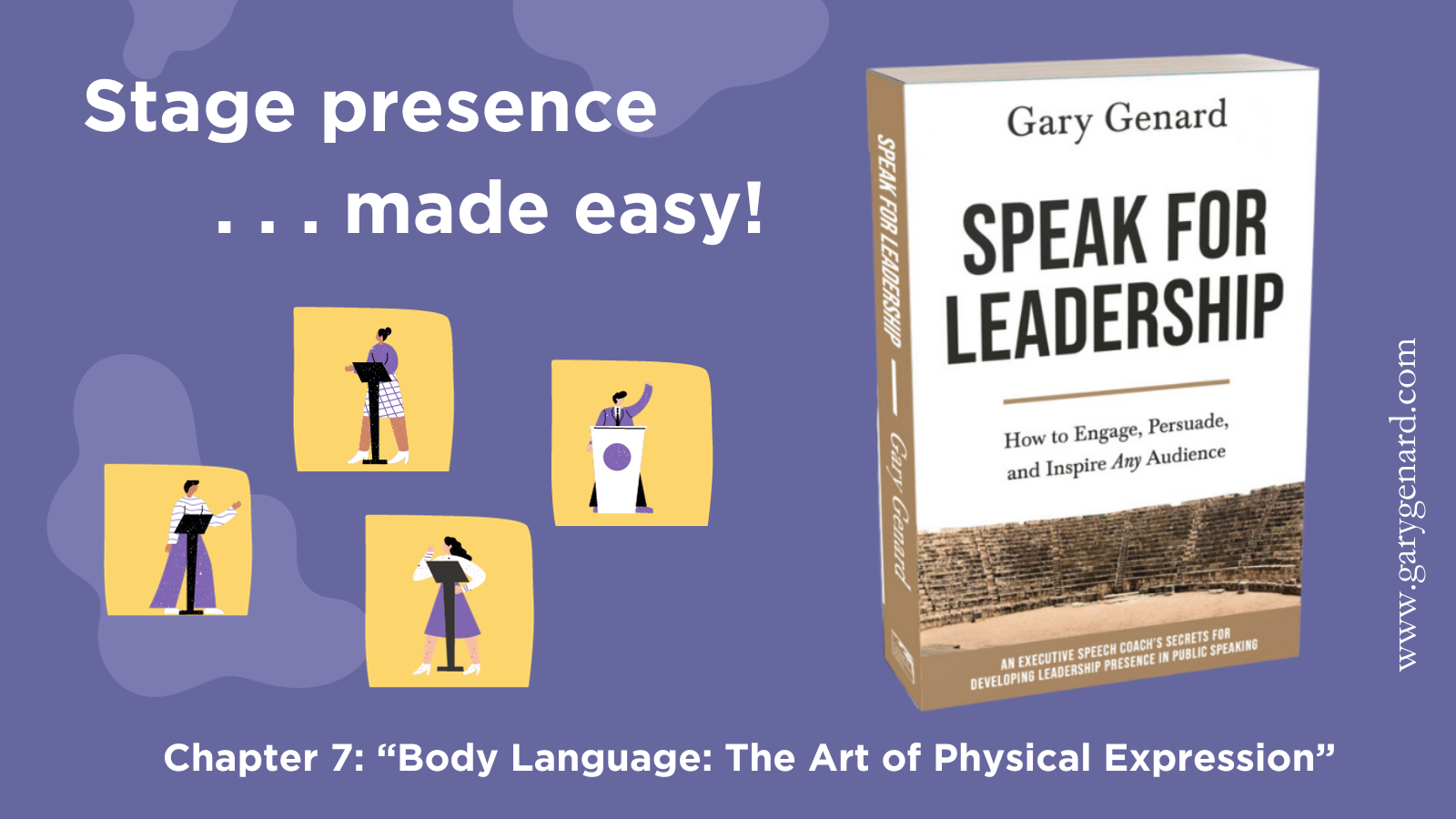An all-time favorite question asked of speech coaches is, "What should I do with my hands?"
No wonder! A mysterious change occurs whenever you get up to speak. Suddenly, you notice strange appendages jutting out from your body: an arm and a hand . . . on both sides! You never gave much thought to these things before, say, when you were having a conversation. But now, here they are, and you're wondering what in the world you're supposed to do with them.
Your presence in a speech or presentation is as important as anything you say! Learn the art of physical expression in my book, Speak for Leadership. On Amazon. Or click below.
Understanding the Role of Gestures
Sigmund Freud probably didn't say (though he should have), that "Sometimes a cigar is just a cigar." Whoever made the statement first couldn't have said the same thing about gestures, though. The reason we use any tool of nonverbal communication is . . . well, let's start there.
Nonverbal communication means saying something without words. And this form of "speaking" can be quite efficient and eloquent. Let's say I just saw the latest blockbuster at the multiplex and you ask, "What do you think?" I shrug my shoulders, put a dismissive look on my face and say, "Eh" or "Meh." What more needs to be "said"? You understand me perfectly (and I may have saved you some money besides).
All of this reminds us that expression-without-words can be clear and sometimes powerful. There's no doubt that you should learn how to use body language for greater impact and persuasiveness. That's exactly where gestures come in. A gesture amplifies, supports, or illustrates what you're saying. As a communication aid, it enlists a very powerful tool in your toolbox: your body.
Owning a stage using strong body language is key to speaking for leadership! Learn how it's done with my Business Speaker's Library. On Amazon. Or click on the image below.
What's the Rule for When to Gesture?
But gestures are problematic for speakers for the simple reason that they are a focus of self-consciousness. For some reason, one part of our body takes center-stage for us (especially when we ourselves are center-stage), essentially announcing: "Hey, forget about what you're saying. What are you going to do about us?"
I have no idea why this happens. Why, for instance, don't be start obsessing about where our feet are pointed? Or whether our posture is as straight as it should be? Similarly, we don't suddenly start asking ourselves, "Is my behind sticking out too much?"
How about more specifics? Download my Free cheat sheet, "Body Language for Public Speaking—6 Skills Building Exercises." Tap into your dynamic energy for speaking power!
But those arms and hands? Oh, yes, they can suddenly fill our consciousness like kudzu. Why? For the simple reason that whether we ignore or use them, they have become an inorganic part of our communication with our audience. The solution is simple: forget about them. Instead of allowing them into your consciousness, follow this rule: Create the conditions for the gesture, rather than the gesture itself. That is, invest yourself fully in your message. Inhabit it, from the inside outwards. If you do, a gesture will emerge as a natural part of your need to amplify what you're saying at that moment. Another way to think of all this: Gesture only when you CAN'T NOT GESTURE any longer. Obey that strong double negative!
Am I Using My Hands Too Much?
If you're asking yourself that question, the answer is, "Probably." Again, you're focusing on gestures, when they must be a spontaneous way to amplify a statement. (And here's my Free e-guide on "Negative Body Language: The 7 Deadly Sins of Nonverbal Communication.")
In terms of expediency, there are two reasons you shouldn't gesture repeatedly. First, a repetitive gesture calls attention to itself. And second, if you're punching up everything you say with a gesture, you're really telling your audience that nothing in particular is important. Instead, make your gestures few in number, and well defined in terms of physical movement.
What Makes a Gesture Effective?
The answer to this question lies in the previous sentence. If your gesture is clean and emphatic, what you just said will come across more strongly. (And conversely, gestures that are unrelated to what you're saying will be confusing and draw unwarranted attention.)
I'm not going to include here a list of "the best gestures" to use. As you may have gathered by now, doing that just doesn't make sense. A gesture should arise organically from your point itself, and (as I say above), should appear at the exact moment it NEEDS to be there.
Finding Your Center: But I will say this: make your gestures come from your center, and not from "the fringes." Imagine an invisible box—similar to the strike zone in baseball, but a bit smaller. This "box" goes from shoulder to shoulder, and downward to your waist. All of your gestures should emerge from inside this box, and no gestures should start outside of the box.
In this way, your gestures come from your center . . . which is exactly where ALL of your physical presence onstage should begin. Keep the gestures tight and strong, and don't allow them to go too far outside the box (though slightly outside is okay). Avoid letting your arms and hands flail in the air, far away from your core. And especially, don't use gestures that are above your shoulders. You'll just be tossing away power from the engine of your center, from which all of your energy should emanate.
You should follow me on Twitter here.
Gary Genard is an actor, author, and expert in public speaking and overcoming speaking fear. His company, The Genard Method offers live 1:1 Zoom executive coaching and corporate group training worldwide. In 2022 for the ninth consecutive year, Gary has been ranked by Global Gurus as One of the World’s Top 30 Communication Professionals. He is the author of the Amazon Best-Seller How to Give a Speech. His second book, Fearless Speaking, was named in 2019 as "One of the 100 Best Confidence Books of All Time." His handbook for presenting in videoconferences, Speaking Virtually offers strategies and tools for developing virtual presence in online meetings. His latest book is Speak for Leadership: An Executive Speech Coach's Secrets for Developing Leadership Presence. Contact Gary here.
Main photo credit: Igreja Dimensão and pexels.com.






